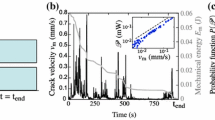Abstract
The progression of structural material towards failure may be thought of in terms of the evolution of the population of defects that it contains. An important statistical characteristic of the defect population is its size distribution. In the present paper we review the results of experimental observations of defect size evolution during damage accumulation due to different mechanisms and at different scales, i.e. creep bubbles, pores and cavities. We consider the probability density functions and cumulative density functions for defect size distributions, and identify several types of evolution observed. We also focus on the appearance of a `tail' of large size defects, and discuss whether it could be used as an indicator of the transition to a new structural level or scale.
Similar content being viewed by others
References
Bae, D.H. and Ghosh, A.K. (2002). Cavity growth during superplastic flow in Al-Mg alloys: Experimental study, Acta Metall. 50, 993-1009.
Balankin, A.S. (1997). Physics of fracture and mechanics of self-affine cracks, Engineering Fracture Mechanics 57(N2-3), 135-203.
Barenblatt, G.I. (1996). Scaling, Self-similarity, and Intermediate Asymptotics: Dimensional Analysis and Intermediate Asymptotics, Cambridge University Press, Cambridge.
Bazant, Z. (2002). Scaling of Structural strength, Hermes Penton Ltd.
Botvina, L.R. and Barenblatt, G.I. (1985). Self-similarity of damage accumulation, Problems of Strength N 12, 17-24.l
Botvina, L.R. and Zharkova, N.A. (2001) Evolution of size distribution curves in conditions of irradiation and thermal fatigue, Fizika i chimiya obrabotki materialov (in Russian), N1, 8-16.
Carpinteri, A. and Chiaia, B. (1996). Power Scaling laws and Dimensional Transitions in Solid Mechanics, Chaos, Solitons and Fractals 7, 1343-1364.
Chen, I.W. and Argon, A.S. (1981). Creep cavitation in 304 stainless steel, Acta Met. 29, 1321-1334.
Goldshtein, R.V. and Osipenko, N.M. (1992). Hierarchy of structures at fracture, Reports of Russian Academy of Sciences 325, 735-739.
Needham, N.G. and Gladman, T. (1980). Nucleation and growth of creep cavities in a Type 347 steel, Metal Science 14(2), 64-72.
Panin, V.E., Grinyaev, Y.V., Elsukova, T.F. and Ivanchin, A.G. (1982). Structural levels of deformation of solids, Izvestiya vuzov, Physics (in Russian), N6, 5-27.
Panin, V.E. (ed.) (1995). Physical mesomechanics and computer-aided design of materials, in two volumes, 'Nauka', Novosibirsk, Siberian Publishing Firm RAN.
Sadovskij, M.A. (1979). Reports of USSR Academy of Sciences 247, 829.
Yang, M.S., Weertman, J.R. and Roth, M. (1984). A test of grain boundary void growth theories by small angle neutron scattering, Scripta Met. 18, 543-548.
Author information
Authors and Affiliations
Rights and permissions
About this article
Cite this article
Korsunsky, A., Kim, K. & Botvina, L. An analysis of defect size evolution. International Journal of Fracture 128, 139–145 (2004). https://doi.org/10.1023/B:FRAC.0000040976.04622.bb
Issue Date:
DOI: https://doi.org/10.1023/B:FRAC.0000040976.04622.bb




